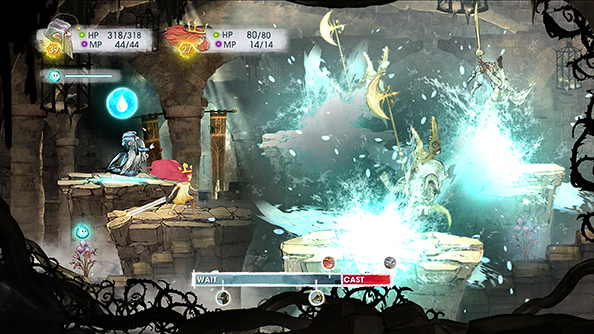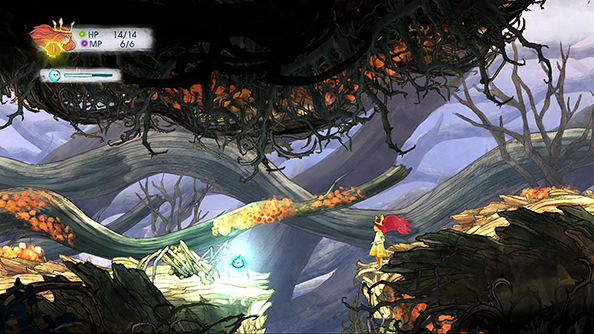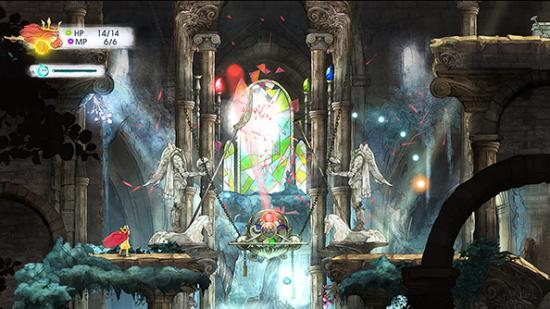Child of Light is a side-scrolling RPG from a talented team of people that includes two of the men who helped create Far Cry 3. In it you play Aurora, the spirit of an Austrian princess trapped inside (something like) the memory of a dream of an afterlife of a whisper of a cloud. Child of Light is very lovely, a soothing soundscape of gentle piano tinkling and drawn out string quartets set against a hand-drawn and pastel coloured backdrop.
You’re on a quest to retrieve the sun and the moon and the stars. You can fly, everybody speaks in rhyming couplets, your best friend is a teardrop and you collect forgotten wishes. The only way Child of Light could be any more ethereal is if it appeared hovering at the foot of your bed.
So it’s surprising that the game feels so substantial to play. The RPG elements come into play every time you come into contact with an enemy in the overworld, which triggers a Paper Mario style combat encounter, one that places you and your allies on one half of the screen and your enemies on the other.
In fights, a shared timeline appears at the bottom of the screen. Each combatant has their own icon on this timeline and moves from left to right along it depending on their speed stat. Around four fifths of the way along the timeline is the point at which you may choose an action — defend, cast a spell, drink a potion, run away, these sorts of things — and from there until the end of the timeline that action is charged, then carried out once your icon reaches the timeline’s end.

That’s a fairly robust combat mechanic, one that’s difficult to comprehensively explain and absolutely in contrast to the rest of the game’s thematically laid back attitude. It gives rise to all sorts of combat trickery. Anybody who’s attacked between choosing their action and carrying it out (in that last fifth of the timeline) will be interrupted, their attack cancelled and their icon sent back to the timeline’s beginning. So the enemy you choose to attack (you can, typically, only choose one) is most often the one whose attack you want to halt, the enemy whose icon is in that critical part of the timeline.
Managing the speeds at which everybody scoots along the timeline becomes terribly important. Some spells take longer to cast than others, which means you often have to risk being interrupted to cast your more powerful abilities. To mitigate this you can use the ‘defend’ action, which protects you from interruption, sets you back to the timeline’s start and increases your movement speed along it. You can use your teardrop sidekick to slow enemy progress along the line, or cast slowing spells on them, or quickening spells on yourself. The timeline is a big deal and tough to master.

Fights reward you with XP that’s used to unlock new skills. Some characters are more proficient at physical combat, others have skill trees that focus on status effects, while some are masters of elemental magic. The progression system goes even further, with augments in the form of special crystal shards that can be applied to weapons and armour, or combined to form even more powerful crystals. Two hours in, you’ll start encountering special elemental enemies and boss fights that test your understanding of all of these systems: multi-headed hydra, spiders made of ice, all manner of things.
For a game in which you collect scraps of poetry floating on the breeze, Child of Light is unexpectedly challenging. It’s also incredibly charming and so outrageously twee that you can’t help but be absorbed by its surprisingly diverse world of desertscapes, haunted jungles and subterranean cave systems. Flying about Child of Light’s levels and solving simple block and maze puzzles is a delightfully carefree distraction from the deeply tactical RPG combat underpinning it. An enigmatic and artistic adventure with some disarmingly well-developed and hidden strategy depths. Lovely lovely, you should definitely get it.
Child of Light is out on April 30th, on all of the things.
